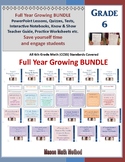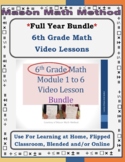6th Grade Math Mod 1 Video Lesson 9-10 Equivalent Ratio Tables Distance/Flipped
- Streaming Video(cannot be downloaded)
- Supporting Information
Also included in
- This is a growing bundle. Please read the product description carefully to understand which resources are included and which have not yet been added.This bundle includes all of my 6th grade math material in my store. You will literally have everything you will need to teach 6th grade math with thisPrice $597.98Original Price $854.25Save $256.27
- 6th Grade Math Module 1 Video Lessons are ready to go and I am excited to offer them to you and your students. Are you considering Flipped Learning this coming year? Will students be learning virtually and you want them to have access to video lessons they can refer to for extra help? Do you plan onPrice $64.00Original Price $80.00Save $16.00
- 6th Grade Math Video Lessons are ready to go and I am excited to offer them to you and your students in this FULL YEAR VIDEO LESSON BUNDLE. Are you considering Flipped Learning this coming year? Will students be learning virtually and you want them to have access to video lessons they can refer to fPrice $321.30Original Price $459.00Save $137.70
- This download contains 6th grade math Module 1 Topic A-D Lesson 1-28 Bundle that includes PowerPoint Lessons, video lessons, topic quizzes and mid-module & end-of-module tests, and interactive notebook/booklet. I had many write and ask me if I could put smaller bundles together that included thPrice $167.85Original Price $167.85
Description
6th Grade Math Module 1 Lesson 9-10 Video Lesson on Equivalent Ratio Tables is ready to go! Are you considering Flipped Learning this coming year? Will students be learning virtually and you want them to have access to video lessons they can refer to for extra help? Do you plan on having your student’s home-schooled this coming year and you want them to get the same instruction they would if they were attending an in-person classroom? Teachers, do you sometimes wonder what you will do if and when you need to miss school due to an illness, or for some other reason, you can have your substitute use these video lessons to help keep your students on track.
I used the PowerPoint lesson I created and used in my classroom to teach students virtually. I talked directly to students throughout, as if they were actually right there with me AND tried to anticipate misconceptions by making sure I pointed those out. I am NOT a perfect person, NOR do I claim to be the best math teacher in the world BUT I do my best and used various different methods to help students the best way I possibly could given that those who watch and learn from video lessons will get the best I can offer as a 6th grade math teacher.
I used Engage NY/Eureka using CCSS to inspire this video lesson. Students don’t need anything except a piece of paper and pencil to follow along. This video lesson is made for a 60 minute class. You may wonder why the duration is less than 60 minutes. Answer: I ask students to pause throughout to solve questions independently and some questions may only take students a few minutes while others may take students up to 20 minutes for independent work followed with me going over the answers.
If you want a preview of what these lessons look like and how I go through a lesson please download a FREE copy of Module 1 Lesson 1 on Ratios CLICK HERE OR for a FREE copy of Module 1 Lesson 2 also on Ratios CLICK HERE
If you are interested in Module 1 Topic A-D Lessons 1-28 Video Lesson Bundle please CLICK HERE
If you are interested in my 6th Grade Math Video Lessons GROWING BUNDLE (Current and Future 6th Grade Math Video Lessons) totaling 94 that can be used to teach for the entire year please CLICK HERE
If you are interested in my 6th Grade Math GROWING BUNDLE (Everything you will need for the ENTIRE 6th Grade Math Year); which includes not only this amazing video lesson, but all the video lessons I have already created and those to come as well as the PowerPoint’s used to create the video lessons, Module 1-6 topic quizzes, mid-module, and end-of-module tests, interactive notebook/booklets, Know & Show Teacher Guide, and editable Lesson Plan Template, various 6th practice worksheets, activities, and all other material I will be including please CLICK HERE
If you are ONLY interested in obtaining my PowerPoint Bundle so you can teach the lessons yourself please check out my 6th Grade Module 1-6 PowerPoint Lesson Bundle. CLICK HERE
Below I have listed what you will be getting in this download.
Duration example: 24:32 means 24 minutes and 32 seconds)
Module 1: Ratios Video Lesson
- Lesson 9-10 Combo: Equivalent Ratio Tables (26:52)
COPYRIGHT TERMS: This resource may not be uploaded to the internet in any form, including classroom/personal websites or network drives, unless the site is password protected and can only be accessed by students. Violations are subject to the penalties of the Digital Millennium Copyright Act.
Attention Districts and Departments: If you are purchasing for your school’s department, please buy the appropriate amount of licenses. If you are a large school district and you are interested in a full district license, please contact me for a district-wide quote.
LICENSING TERMS: This purchase includes a license for one teacher only for personal use in their classroom. Licenses are non-transferable, meaning they cannot be passed from one teacher to another. No part of this resource is to be shared with colleagues or used by an entire grade level, school, or district without purchasing the proper number of licenses. If you are a coach, principal, or district interested in transferable license to accommodate yearly staff changes, please contact me for a quote





